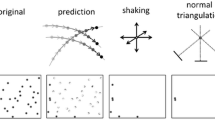Abstract
A stereoscopic PIV (Particle Image Velocimetry) technique was used to measure the three-dimensional flow structure of the turbulent wake behind a marine propeller with five blades. The out-of-plane velocity component was determined using two CCD cameras with an angular displacement configuration. Four hundred instantaneous velocity fields were measured for each of four different blade phases, and ensemble averaged in order to find the spatial evolution of the propeller wake in the region from the trailing edge up to one propeller diameter (D) downstream. The influence of propeller loading conditions on the wake structure was also investigated by measuring the velocity fields at three advance ratios (J=0.59, 0.72 and 0.88). The phase-averaged velocity fields revealed that a viscous wake formed by the boundary layers developed along the blade surfaces. Tip vortices were generated periodically and the slipstream contracted in the near-wake region. The out-of-plane velocity component and strain rate had large values at the locations of the tip and trailing vortices. As the flow moved downstream, the turbulence intensity, the strength of the tip vortices, and the magnitude of the out-of-plane velocity component at trailing vortices all decreased due to effects such as viscous dissipation, turbulence diffusion, and blade-to-blade interaction.















Similar content being viewed by others
References
Calcagno G, Di Felice F, Felli M, Pereira F (2002) Propeller wake analysis behind a ship by stereo PIV. Proc of 24th Symposium on Naval Hydrodynamics, Fukuoka, 3:112–127
Chesnaks C, Jessup S (1998) Experimental characterisation of propeller tip flow. Proc of 22nd Symposium on Naval Hydrodynamics, Washington D.C., pp 156–169
Cho CH, Lee CS (2000) Numerical experimentation of a 2-D B-spline higher order panel method. J Soc Naval Architects Korea 37(3):27–36
Cotroni A, Di Felice F, Romano GP, Elefante M (2000) Investigation of the near wake of a propeller using particle image velocimetry. Exp Fluids 29:S227–236
Lee JT (1987) A potential-based panel method for the analysis of marine propellors in steady flow, Ph. D. Thesis, Dept. Ocean Engineering, MIT, Mass.
Lee SJ, Paik BG, Lee CM (2002) Phase-averaged PTV measurements of propeller wake. Proc of 24th Symposium on Naval Hydrodynamics, Fukuoka, 4:18–25
Prasad AK, Adrian RJ (1993) Stereoscopic particle image velocimetry applied to liquid flows. Exp Fluids 15:49–60
Soloff SM, Adrian RJ (1997) Distortion compensation for generalized stereoscopic particle image velocimetry. Meas Sci Technol 15:1441–1454
Stella A, Guj G, Di Felice F, Elefante M (1998) Propeller wake evolution analysis by LDV. Proc of 22nd Symposium on Naval Hydrodynamics, Washington D.C., pp 171-188
Yoon JH, Lee SJ (2002) Direct comparison of 2-D PIV and 3-D stereoscopic PIV measurements. Meas Sci Technol 13:1631–1642
Acknowledgements
The present work was supported by the National Research Laboratory Program of the Ministry of Science and Technology (MOST) of Korea.
Author information
Authors and Affiliations
Corresponding author
Rights and permissions
About this article
Cite this article
Lee, S.J., Paik, B.G., Yoon, J.H. et al. Three-component velocity field measurements of propeller wake using a stereoscopic PIV technique. Exp Fluids 36, 575–585 (2004). https://doi.org/10.1007/s00348-003-0699-5
Received:
Accepted:
Published:
Issue Date:
DOI: https://doi.org/10.1007/s00348-003-0699-5




